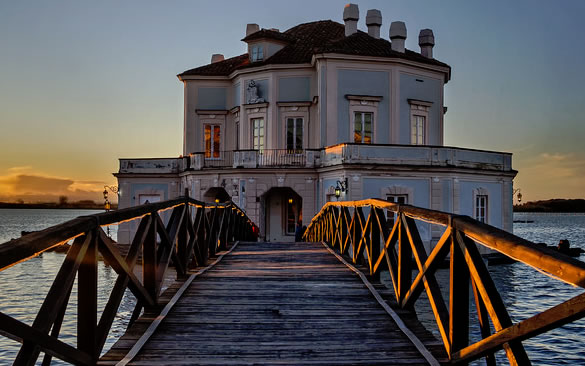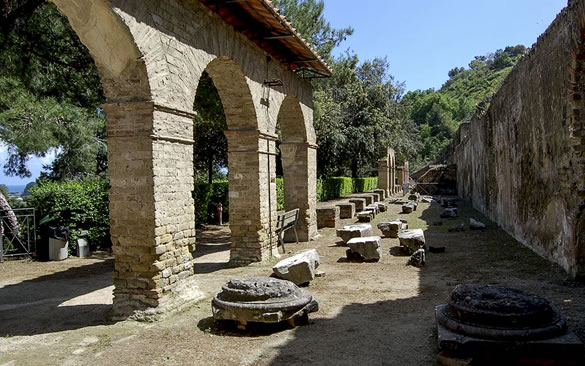
Campi Flegrei which means "fiery fields", extending from Camaldoli to Capo Miseno and Cuma
The birth of the Phlegraean Fields dates back to about 30,000,000 years ago.
Various eruptions formed many volcanic craters which, even today, travelling by coach with tourists, there is the continuous awareness of entering one crater and leaving another.
The last eruption dates back to 1538 with the birth of Monte Nuovo near Pozzuoli.
Currently the only active volcano is the Solfatara.
There were 3 eruptive periods: In the first,volcanic rock was expelled, gray tuff, lava, pumice and rubble, particularly in Camaldoli.
The 2nd period produced mainly yellow tuff throughout the Flegrean area from underwater volcanoes. In the 3rd period volcanic activity of a lower intensity was subaereal, with expulsions of trachiandesitic material, mainly in the volcanoes of Solfatara, Astroni and Agnano.
The qualified and registered specialist tour guide proposes and shows the following sites in the Phlegraean Fields:
The town of Pozzuoli, founded in 529 BC was given the name of Dikaiarchia (right government) from the settlers of Samos. In the area of the port, which became one of the most important ports of the Mediterranean, the so-called Temple of Serapis, built by the Flavians and rebuilt by the Antonines and the Severi is situated.
The entrance to the temple, which in truth, was a macellum (market building) was on the side facing the sea.
Flavio Amphitheatre, the amphitheatre of Pozzuoli is third in size after that of Rome andSanta Maria Capua Vetere. It had a capacity of approx. 40,000 places and dates back to the Vespasian empire
Baia, according to legend, derives its name from Baios, one of the companions of Ulysses, buried and honoured here.Baia was enriched by many villas belonging to famous Romans such as Licinius Crassus, Caesar, Pompey, Varro, Ortensio and Cicero. Orazio declared Baia one of the most enchanting places in the world.
One of the largest housing complexes are the so-called Terme di Baia (Baths of Baia) which in truth is an imperial domus with the baths attached. Following the bradyseism part of the complex was submerged up to 10 meters deep by the sea.
Bacoli iswhere we can find the so-called tomb of Agrippina, who was killed in the temple of Hercules and buried in the villa of Caesar.
Centum Cellae is a great deposit of drinking water cisterns.
The cisterns were connected to each other and completely covered with "cocciopesto" (mortar made with perlite and clay), an impermeable material to prevent water leaks.
The Mirabile pool, built by Agrippa, was a large cistern of drinking water that served to restore the Roman fleet that was stationed at Miseno. The water came from the Serino.
Cuma is the oldest Greek colony on Italian soil, founded by the Chalcis of Euboeain the eighth century BC.
In the period of its maximum splendor, the power of the city spread over the whole Phlegrean region, as well as on the foundation of Neapolis (Naples). The most evocative place is the Sibyl cave, the place where the Cumaean Sibyl shared her proficies, is an artificial gallery of the Greek-Roman era, found following the archaeological excavations of the city of Cuma.
Lake D'Averno, is a crater lake and is so named for the emission of poisonous gases, which emanated, killing any form of life, whether aquatic or winged, in fact Avernus means hell.
Agrippa connected lake D'Averno with Lake Lucrino via canal and also to the sea, thus obtaining a very safe military port.
Solfatara, the Volcanic Forum of the ancients, crater of a volcano in the quiescent state is the classic example of volcanoes during the phase of solfatara.
The phenomena of volcanic activity are emissions of sulfur, arsenide, carbon dioxide and mineral water springs (fumarole) and hot mud jets (mud volcanoes).
The crater has a circumference of 2.3 km and a depth of 92 metres.
Book with our local GTA guide your excursion!
We offer discounts on rates depending on the period, the number of passengers and the number of services requested.
Each tour can be combined as desired, always contacting us via the form.
Mini-group
(8 to 15 pax)
€ 15.00 per pax
Duration:
3 Hours about
Suitable for families:
Yes
Suitable for the disabled:
No
Meeting place:
Entry sites required
Skip the line:
Yes
Language:
Italiano, English, Deutsch
Type Guide:
Local guide enabled in archaeological tours
More info:
We recommend comfortable shoes; within the site smoking is prohibited.

